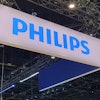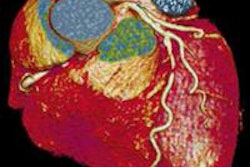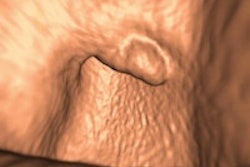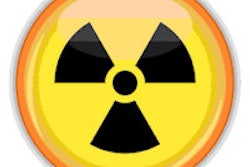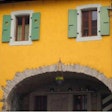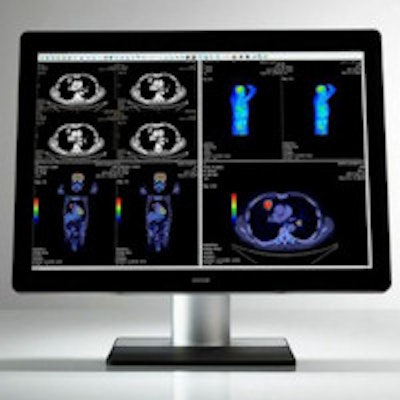
In the world of medical displays, a gulf has always existed between grayscale and color, with imaging facilities maintaining separate types of monitors for optimal performance. Display vendor Barco hopes to bridge the divide through Coronis Uniti, a new display designed for both grayscale and color applications.
Barco is due to launch Uniti on October 17 at the Journées Françaises de Radiologie (JFR) meeting in Paris, positioning the display as a new tool that will help radiologists cope with an increasingly stressful reading environment. By unifying grayscale and color reading on a single screen, Uniti eliminates eye strain and ergonomic stress that can be caused by using multiple separate monitors, according to the company.
Radiologists can use the 12-megapixel Uniti for diagnostic interpretation of both breast and general radiology images, in either grayscale or color. Gone is the need to shift from PACS workstations to specialized monitors required for different types of medical images, according to Albert Xthona, senior product manager at Barco.
"Today, people have very nice grayscale, but they have another display with color. They are constantly torn to use the grayscale to get the best detail, or use the color to get the color information," Xthona said in a press conference. "They are literally dragging the study from one to the other because they have to use the two environments."
This can affect both the productivity and health of radiologists, especially as they are being required to do more with less. Radiologists are reporting higher levels of occupational stress and are looking for tools that will help them load and work through images more quickly, according to Lynda Domogalla, vice president of product marketing in Barco's health division.
 Barco's Coronis Uniti is designed to be a single display for all diagnostic image interpretation needs. Image courtesy of Barco.
Barco's Coronis Uniti is designed to be a single display for all diagnostic image interpretation needs. Image courtesy of Barco.Barco is backing up its claims with data. Prior to Uniti's launch, the company commissioned market research firm the MarkeTech Group to conduct a survey of several hundred radiologists in the U.S., U.K., France, and Germany on their reading practices.
Survey respondents reported using an average of 3.6 displays (diagnostic and nondiagnostic) per radiology workstation, and 61% of practices reported using both color and grayscale displays. Perhaps as a result, respondents also reported a variety of ergonomic problems, with 66% reporting eye fatigue, 56% complaining of neck strain, and 52% reporting back pain, among other conditions.
The survey results speak to the changing nature of the radiology reading room, according to Domogalla.
"Radiologists are reading a variety of images and are looking for color and grayscale on the same display," she said. "For someone doing that every day, it adds to their sense of fatigue after a reading session."
Unifying the two environments is more complex than simply adding color to a grayscale display, however. Calibration is key to maintaining quality for any display used in a mission-critical application such as diagnostic image interpretation, and color calibration previously hadn't reached the level achieved with grayscale displays. In fact, it took Barco several years to develop a display that had the benefits of color without influencing any of the image quality needed for grayscale breast imaging, Domogalla said.
Barco addressed the problem directly with a variety of tools designed to monitor and correct color calibration, such as SteadyColor, which makes color shades more meaningful, as well as better color stabilization. The company believes the tools will prove useful as color becomes increasingly common in medical imaging, such as for ultrasound elastography studies or monitoring the wash-in and wash-out of contrast on breast MRI scans.
Other Uniti features include the following:
- RapidFrame, first introduced on Barco's display for digital breast tomosynthesis, which keeps moving images sharp and in focus
- Barco Optical Glass, which reduces reflection off the display by a factor of three for sharper images with up to 12 times more local contrast
- I-Luminate, a feature that doubles the display's normal luminance of 1,000 candela (cd) to more than 2,100 cd
- SpotView, which enables users to focus on certain portions of an image to see more detail
- SoftGlow, a task light for illuminating folders
- A wall light for adjusting ambient lighting, another important ergonomic consideration
- A viewing field that matches that of the human eye, at ± 30º
Other technical specifications are shown in the table below.
| Coronis Uniti technical specifications | |
| Megapixels | 12 |
| Display size | 33.6 inches (853.44 mm) |
| Resolution | 4200 x 2800 pixels |
| Pixel pitch | 0.1686 mm |
| Viewing angle | 178°, 178° |
| Maximum luminance | > 2,100 cd/m2 |
All Uniti packages come with Barco's display controller and quality assurance software, and users can modify the display's ambient light to make the reading space more comfortable.
Barco has received U.S. Food and Drug Administration (FDA) clearance, and Uniti shipments are beginning this month. After this week's JFR debut, Barco will highlight the display at the EHI Live 2014 congress, which is being held in the U.K. on November 4 and 5, and then at the upcoming RSNA 2014 meeting in Chicago.
